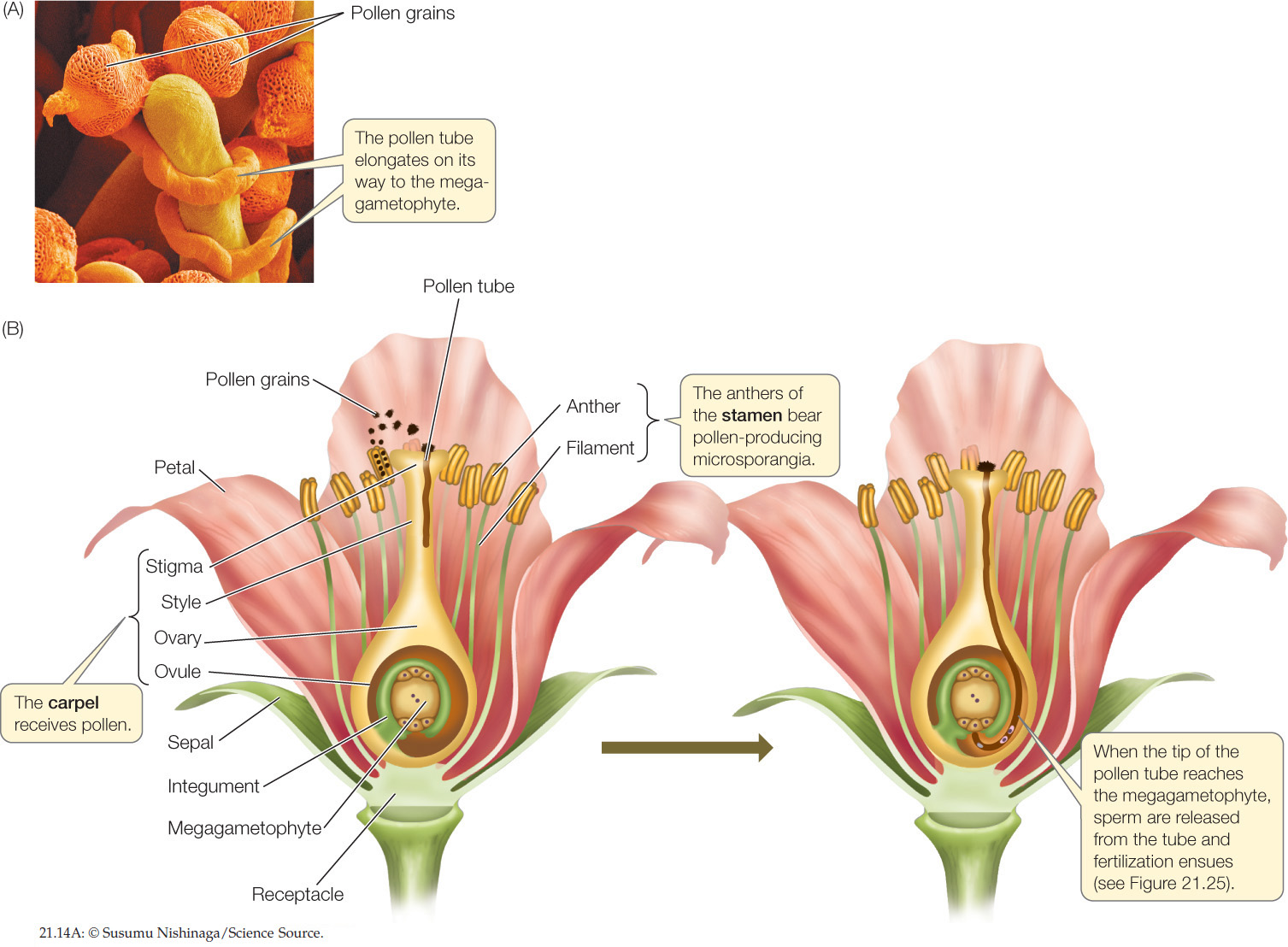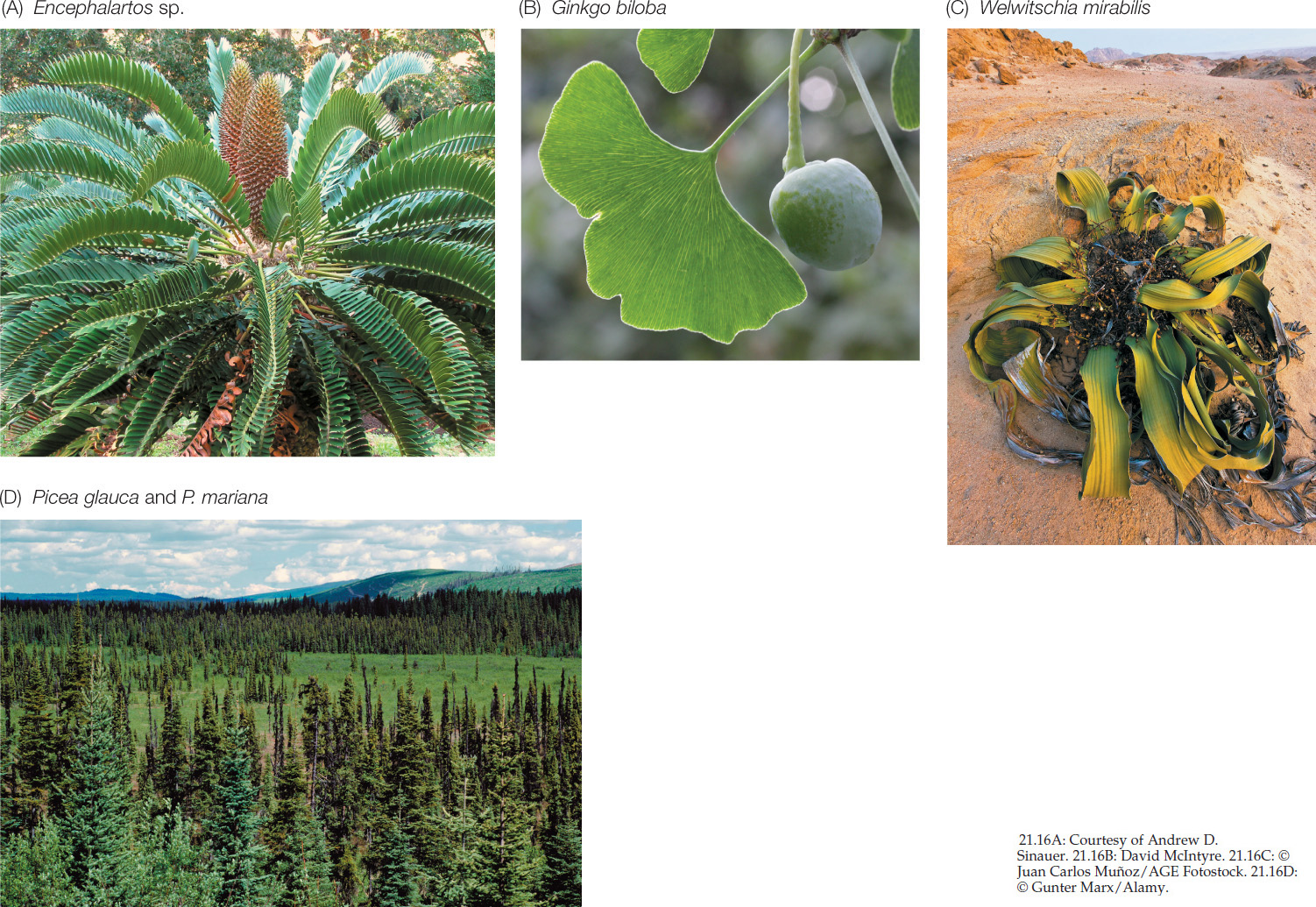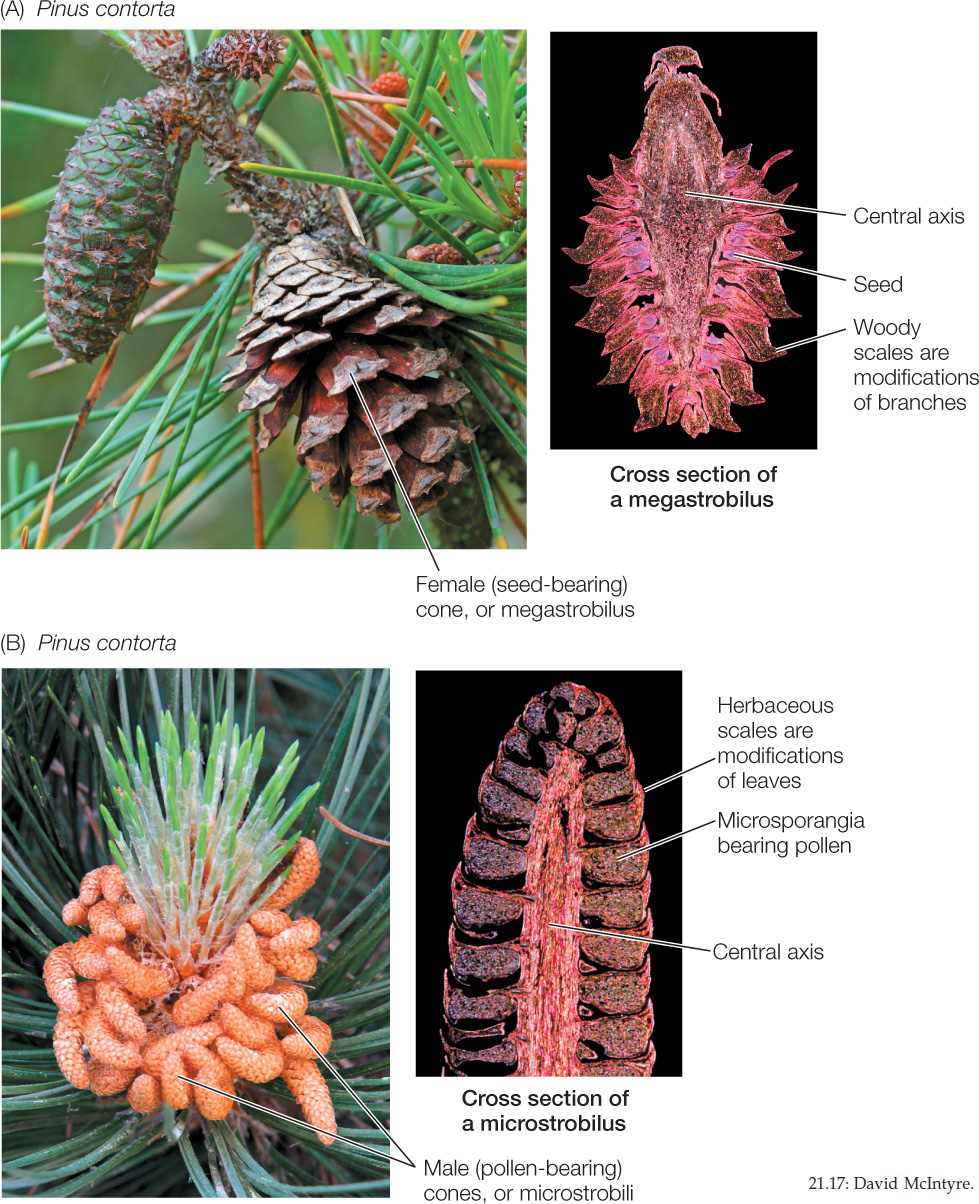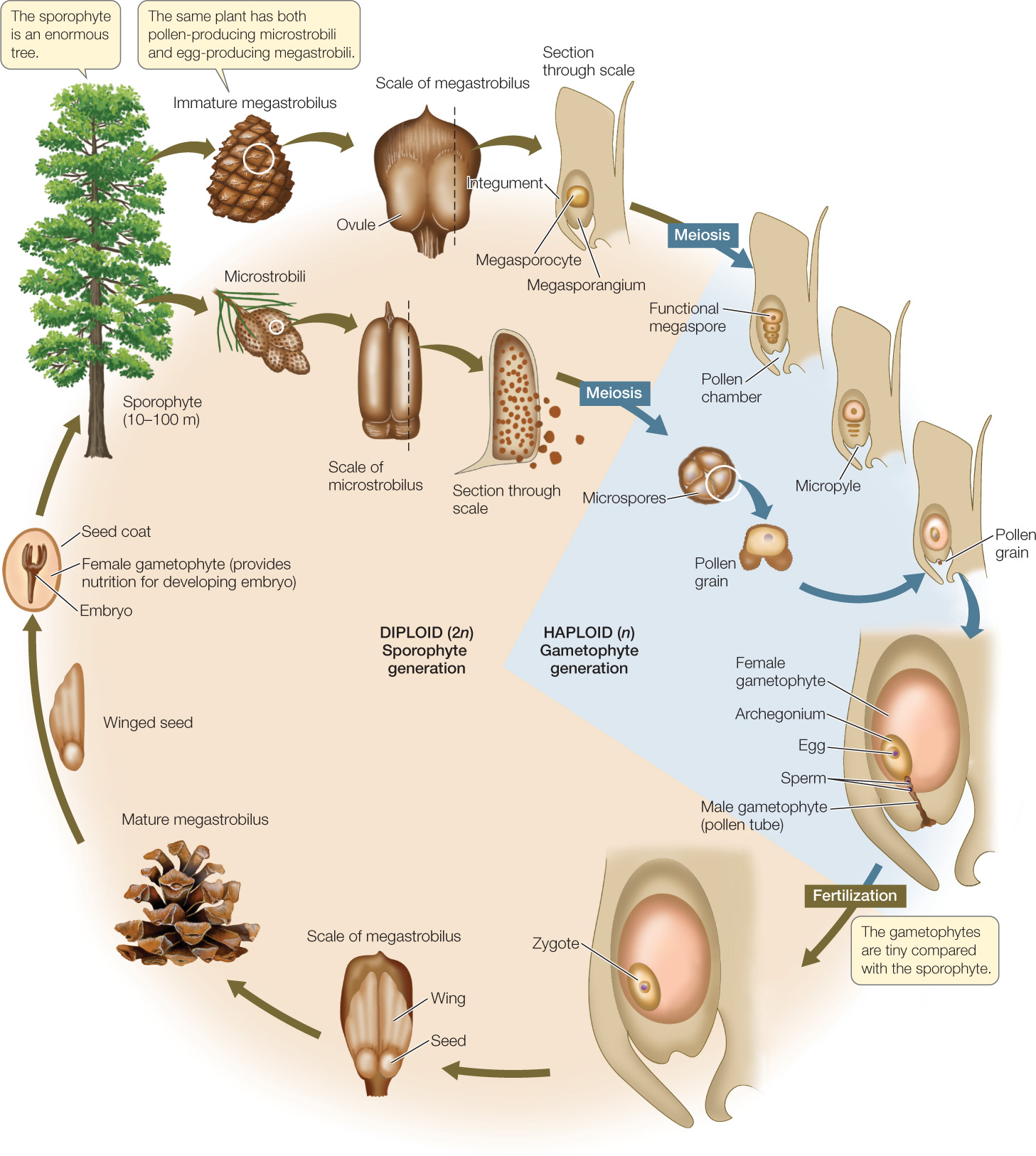Concept 21.4: Seeds Protect Plant Embryos
The seed plants—the gymnosperms and the angiosperms—provide a secure and lasting dormant stage for the embryo, known as a seed. In seeds, embryos may safely lie dormant, in some cases for many years (even centuries), until conditions are right for germination. How is this protection provided?
Features of the seed plant life cycle protect gametes and embryos
In Concept 21.2 we described a trend in plant evolution: the sporophyte became less dependent on the gametophyte, which became smaller in relation to the sporophyte. This trend continued with the seed plants, whose gametophyte generation is reduced even further than it is in the ferns (FIGURE 21.12). The haploid gametophyte develops partly or entirely while attached to and nutritionally dependent on the diploid sporophyte.

433
Among the seed plants, only the earliest diverging groups of gymnosperms (including modern cycads and ginkgos) have swimming sperm. Even in these groups, sperm is transferred via pollen grains, so fertilization does not require liquid water outside the plant body. The evolution of pollen, along with the advent of seeds, gave seed plants the opportunity to colonize drier areas and spread over the terrestrial environment.
Seed plants are heterosporous (see Figure 21.11B)—that is, they produce two types of spores, one that becomes a microgametophyte (male gametophyte) and one that becomes a megagametophyte (female gametophyte). They form separate microsporangia and megasporangia on structures that are grouped on short stems, such as the stamens and carpels of an angiosperm flower.
Within the microsporangium, the meiotic products are microspores. Within its spore wall, a microspore divides mitotically one or a few times to form a multicellular male gametophyte called a pollen grain. Pollen grains are released from the microsporangium to be distributed by wind or by an animal pollinator (FIGURE 21.13). The spore wall that surrounds the pollen grain contains a substance called sporopollenin, the most chemically resistant biological compound known. Sporopollenin protects the pollen grain against dehydration and chemical damage—another advantage in terms of survival in the terrestrial environment.


Go to MEDIA CLIP 21.4 Pollen Transfer by Wind
PoL2e.com/mc21.4
In contrast to the microspores, the megaspores of seed plants are not shed. Instead they develop into female gametophytes within the megasporangia. These megagametophytes are dependent on the sporophyte for food and water.
In most seed plant species, only one of the meiotic products in a megasporangium survives. The surviving haploid nucleus divides mitotically, and the resulting cells divide again to produce a multicellular female gametophyte. The megasporangium is surrounded by sterile sporophytic structures, which form an integument that protects the megasporangium and its contents. Together, the megasporangium and integument constitute the ovule, which will develop into a seed after fertilization.
434
The arrival of a pollen grain at an appropriate landing point, close to a female gametophyte on a sporophyte of the same species, is called pollination. A pollen grain that reaches this point develops further. It produces a slender pollen tube that elongates and digests its way toward the megagametophyte (FIGURE 21.14). When the tip of the pollen tube reaches the megagametophyte, sperm are released from the tube and fertilization occurs.

APPLY THE CONCEPT: Seeds protect plant embryos
In 1879 W. J. Beal began an experiment that he could not hope to finish in his lifetime. He prepared 20 lots of seeds for long-term storage. Each lot consisted of 50 seeds from each of 23 species. He mixed each lot of seeds with sand and placed the mixture in an uncapped bottle, then buried all the bottles on a sandy knoll. At regular intervals over the next century, several different biologists have excavated a bottle and checked the viability of its contents. The table shows the number of germinating seeds (of the original 50) from three species in years 50–100 of this ongoing experiment.
- Calculate the percentage of surviving seeds for these three species in years 50–100 and graph seed survivorship as a function of time buried.
- No seeds of the first two species were viable after 90 years of the experiment. Assume 100% seed viability at the start of the experiment (year 0), and predict from your graph the approximate year when you think the last of the Verbascum blattaria seeds will germinate.

- What factors do you think might influence the differences in long-term seed viability among the species?
435
The resulting diploid zygote divides repeatedly, forming an embryonic sporophyte. After a period of embryonic development, growth is temporarily suspended (the embryo enters a dormant stage). The end product at this stage is the multicellular seed.
The seed is a complex, well-protected package
A seed contains tissues from three generations (FIGURE 21.15). A seed coat develops from the integument—the tissues of the diploid sporophyte parent that surround the megasporangium. Within the megasporangium is haploid tissue from the female gametophyte, which contains a supply of nutrients for the developing embryo. (This tissue is fairly extensive in most gymnosperm seeds. In angiosperm seeds it is greatly reduced, and nutrition for the embryo is supplied instead by a tissue called endosperm.) In the center of the seed is the third generation, the embryo of the new diploid sporophyte.

The seed is a well-protected resting stage. The seeds of some species may remain dormant but stay viable (capable of growth and development) for many years, germinating only when conditions are favorable for the growth of the sporophyte. During the dormant stage, the seed coat protects the embryo from excessive drying and may also protect it against potential predators that would otherwise consume the embryo and its nutrient reserves. Many seeds have structural adaptations or are contained in fruits that promote their dispersal by wind or, more often, by animals. When the young sporophyte resumes growth, it draws on the food reserves in the seed. The possession of seeds is a major reason for the enormous evolutionary success of the seed plants, which are the dominant life forms of most modern terrestrial floras.
A change in stem anatomy enabled seed plants to grow to great heights
The earliest fossil seed plants have been found in late Devonian rocks. These plants had extensively thickened woody stems, which developed through the proliferation of xylem. This type of growth, which increases the diameter of stems and roots in some modern seed plants, is called secondary growth, and its product is called secondary xylem, or wood.
The younger portion of the wood produced by secondary growth is well adapted for water transport, but older wood becomes clogged with resins or other materials. Although no longer functional in transport, the older wood continues to provide support for the plant. This support allows woody plants to grow taller than other plants around them and thus capture more light for photosynthesis.
Not all seed plants are woody. In the course of seed plant evolution, many groups lost the woody growth habit. Nonetheless, other advantageous attributes helped them become established in an astonishing variety of places.
Gymnosperms have naked seeds
The two major groups of living seed plants are the gymnosperms (such as pines and cycads) and the angiosperms (flowering plants; see Figure 21.1B). We’ll discuss the flowering plants in Concept 21.5 and examine the gymnosperms here.
The gymnosperms are seed plants that do not form flowers or fruits. Gymnosperms (which means “naked-seeded”) are so named because their ovules and seeds, unlike those of angiosperms, are not protected by ovary or fruit tissue. Although there are probably fewer than 1,200 living species of gymnosperms, these plants are second only to the angiosperms in their dominance of the terrestrial environment. The gymnosperms can be divided into four major groups:
436
- Cycads are palmlike plants of the tropics and subtropics (FIGURE 21.16A). Of the present-day gymnosperms, the cycads are probably the earliest-diverging clade. There are about 300 species, some of which grow as tall as 20 meters. The tissues of many species are highly toxic to humans if ingested.
- Ginkgos, common during the Mesozoic era, are represented today by a single genus and species: Ginkgo biloba, the maidenhair tree (FIGURE 21.16B). There are both male (microsporangiate) and female (megasporangiate) maidenhair trees. The difference is determined by X and Y sex chromosomes, as in humans. Few other plants have distinct sex chromosomes.
- Gnetophytes number about 90 species in three very different genera, which share certain characteristics analogous to ones found in the angiosperms. One of the gnetophytes is Welwitschia (FIGURE 21.16C), a long-lived desert plant with just two permanent straplike leaves, which split into many pieces that sprawl across the sand.
- Conifers are by far the most abundant of the gymnosperms. There are about 700 species of these cone-bearing plants, including the pines, spruce, and redwoods (FIGURE 21.16D).

With the exception of the gnetophytes, the living gymnosperm groups have only tracheids as water-conducting and support cells within the xylem. Most gymnosperms lack the vessel elements and fibers (cells specialized for water conduction and support, respectively) that are found in angiosperms. While the gymnosperm water-transport and support system may thus seem somewhat less efficient than that of the angiosperms, it serves some of the largest trees known. The coastal redwoods of California are the tallest gymnosperms, with some individuals growing to well over 100 meters tall.
During the Permian, as environments became warmer and dryer, the conifers and cycads flourished. Gymnosperm forests changed over time as the gymnosperm groups evolved. Gymnosperms dominated the Mesozoic era, during which the continents drifted apart and large dinosaurs lived. Gymnosperms were the principal trees in all forests until about 65 million years ago, and even today conifers are the dominant trees in many forests, especially at high latitudes and altitudes. The oldest living single organism on Earth today is a gymnosperm in California—a bristlecone pine that germinated about 4,800 years ago, at about the time the ancient Egyptians were starting to develop writing.
437
Conifers have cones and lack swimming sperm
The great Douglas fir and cedar forests found in the northwestern United States and the massive boreal forests of pine, fir, and spruce of the northern regions of Eurasia and North America, as well as on the upper slopes of mountain ranges elsewhere, rank among the great forests of the world. All these trees belong to one group of gymnosperms: the conifers, or cone-bearers.
Male and female cones contain the reproductive structures of conifers. The female (seed-bearing) cone is known as a megastrobilus (plural megastrobili). An example of a familiar megastrobilus is the woody cone of pine trees. The seeds in a megastrobilus are protected by a tight cluster of woody scales, which are modifications of branches extending from a central axis (FIGURE 21.17A). The typically much smaller male (pollen-bearing) cone is known as a microstrobilus. The microstrobilus is typically herbaceous rather than woody, as its scales are composed of modified leaves, beneath which are the pollen-bearing microsporangia (FIGURE 21.17B).

The life cycle of a pine illustrates reproduction in gymnosperms (FIGURE 21.18). The production of male gametophytes in the form of pollen grains frees the plant completely from its dependence on liquid water for fertilization. Wind, rather than water, assists conifer pollen grains in their first stage of travel from the microstrobilus to the female gametophyte inside a cone. A pollen tube provides the sperm with the means for the last stage of travel by elongating through maternal sporophytic tissue. When the pollen tube reaches the female gametophyte, it releases two sperm, one of which degenerates after the other unites with an egg. Union of sperm and egg results in a zygote. Mitotic divisions and further development of the zygote result in an embryo.

Go to ACTIVITY 21.4 Life Cycle of a Conifer
PoL2e.com/ac21.4

Go to ANIMATED TUTORIAL 21.2 Life Cycle of a Conifer
PoL2e.com/at21.2
The megasporangium, in which the female gametophyte will form, is enclosed in a layer of sporophytic tissue—the integument—that will eventually develop into the seed coat that protects the embryo. The integument, the megasporangium inside it, and the tissue attaching it to the maternal sporophyte constitute the ovule. The pollen grain enters through a small opening in the integument at the tip of the ovule, the micropyle.
Most conifer ovules (which will develop into seeds after fertilization) are borne exposed on the upper surfaces of the scales of the cone (megastrobilus). The only protection of the ovules comes from the scales, which are tightly pressed against one another within the cone. Some pines, such as the lodgepole pine, have such tightly closed cones that only fire suffices to split them open and release the seeds. These species are said to be fire-adapted, and fire is essential to their reproduction.
About half of all conifer species have soft, fleshy modifications of cones that envelop their seeds. Some of these are fleshy, fruitlike cones, as in junipers. Others are fruitlike extensions of the seeds, as in yews. These tissues, although often mistaken for “berries,” are not true fruits. As we will see when we discuss angiosperms, true fruits are a plant’s ripened ovaries, which are absent in gymnosperms. Nonetheless, the fleshy tissues that surround many conifer seeds serve a similar purpose as that of the fruits of flowering plants, acting as an enticement for seed-dispersing animals. Animals eat these fleshy tissues and disperse the seeds in their feces, often depositing the seeds considerable distances from the parent plant.
438
439
CHECKpoint CONCEPT 21.4
- Distinguish between the roles of the megagametophyte and the pollen grain.
- Explain the importance of pollen in freeing seed plants from dependence on liquid water.
- What are some of the advantages afforded by seeds? By wood?
- Explain how fire can be necessary for the survival of some plant species.